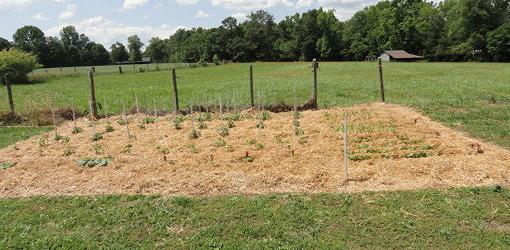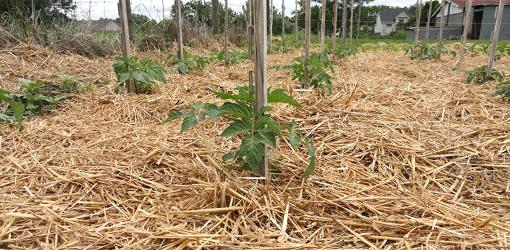Why Do I Need To Weed My Vegetable Garden?

My grandmother's garden is legendary in our family for many reasons, not the least of which is that it was weed-free. After planting, she would spread layers of old newspaper between the rows, to make a nice weed-suppressing barrier that still let moisture through. On top of the newspapers would be a luxuriously thick layer of straw mulch.
The resulting garden not only didn't have weeds, it was mud-free as well. In fact, walking in her garden was like walking on carpet! And at the end of the season, she'd plow all that organic goodness into the soil to spend the winter composting and turning into next year's giant tomatoes. It was a weed-control, pleasure-enhancing, and soil-enriching project, all in one.

Here in the age of mulch yards and landscape companies, it's funny to think that in her day, mulching was a new – and strange – idea. Following the advice of Ruth Stout's No-Work Garden Book, my grandmother's thickly mulched garden was out of place among the bare, plowed (weedy, muddy) garden rows of her generation.
This year I've planted my biggest garden yet, and I've done several things – like the German Johnson tomatoes – in honor of my grandmother. And this weekend, after seeing how quickly the weeds sprouted in my new garden, I decided to give her weed-proofing method a try.

Weed-Proofing a Vegetable Garden
Here in the digital age, we don't have newspapers at our house, so instead I opted for a roll of 100% recycled, biodegradable landscape barrier. It's a sort of brown, thick paper that I spread in strips between the rows. In your garden, you could use:
-
- Paper: I really couldn't tell the difference between plain brown paper and the "landscape barrier" paper I bought, so I think any unbleached, uncolored paper (preferable recycled) would work just fine.

- Cardboard: Cardboard is a great weed barrier, but I would put it only in the aisles, not right up against your plants where it might deflect water or smother roots.
- Newspaper: Talk about home recycling! If you use newspapers as a weed barrier, you might want to make sure the inks are safe for your soil. You can also check with your local newspaper office – they will often give you leftover rolls of clean newsprint for free.
- Landscape fabric: Landscape fabric is great for letting water through, so you can put it closer to your plant stems without worrying about deflecting water. Landscape fabric isn't biodegradable, though, so you'll need to remove it before plowing your garden.
Once the paper was in place, I put down bales upon bales of wheat straw. I wanted that garden so well mulched that it would stay clean, cool, moist, and weed-free even on the hottest of summer days! You can use whatever mulch you like – pine straw, wheat straw, hardwood mulch, you name it – just lay it on thick. I chose wheat straw because it was economical and would break down quickly over the winter.

Finally, since the day had proven challenging with paper-catching breezes, I watered the garden thoroughly to settle down the straw and paper. Now, with everything thickly mulched and the aisles blocked with biodegradable paper, I DARE weeds to sprout!
The best part about this weed-proofing method is that it's completely organic, and this year's mulch will turn into next year's compost. That's about as easy as it gets! And after a few years of mulching and natural composting, I can only imagine how big my tomatoes will be.
Further Information
- Using Mulch in Your Garden (article)
- Tips for Dealing with Weeds in Your Lawn or Garden (video)
- How to Make a Wood Raised Planting Bed for Your Garden (video)
- Types of Mulch for Your Yard (video)
- Tips for Using Mulch in Your Garden (video)
- How to Apply Mulch in Your Yard (video)
- How to Use Shredded Paper as Mulch (video)
Why Do I Need To Weed My Vegetable Garden?
Source: https://todayshomeowner.com/how-to-weed-proof-a-vegetable-garden/
Posted by: sansomcombehe.blogspot.com

0 Response to "Why Do I Need To Weed My Vegetable Garden?"
Post a Comment